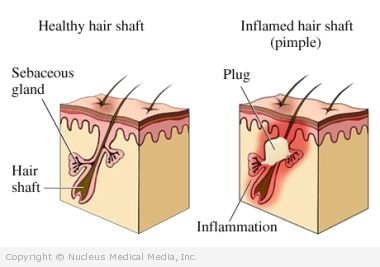(Pimples; Blackheads; Whiteheads; Acne Vulgaris)
Acne – Definition
Acne occurs when the pores of the skin become clogged, inflamed, and sometimes infected. These clogged pores can result in blackheads, whiteheads, or pimples. Acne tends to occur in teenagers, but can also occur in adults.
Acne – Causes
Acne starts in the skin’s sebaceous glands. These glands secrete an oily substance called sebum. The sebum normally travels through a tiny hair follicle from the gland to the skin’s surface. Sometimes the sebum becomes trapped, mixing with dead skin cells and bacteria. This causes clogged pores called comedones.
Blackheads are comedones that reach the skin’s surface. Whiteheads are comedones that stay beneath the surface of the skin. Small red bumps, pimples, and cysts may also develop.
- The main causes of acne include:
- Changes in levels of male hormones called androgens
- Increased sebum production
- Changes inside the hair follicle
- Bacteria
Acne – Risk Factors
A risk factor is something that increases your chances of getting a disease or condition.
- Age: between 12-24 years old
- Race: Caucasian
- Changes in hormone levels, such as during:
- Puberty
- Pregnancy
- Before a menstrual period
- Stress
- Certain medicines (eg, androgens, lithium, and barbiturates)
- Certain cosmetic products
Acne – Symptoms
Acne symptoms vary from person to person and can range from mild to severe. They include:
- Excess oil in the skin
- Blackheads
- Whiteheads
- Papules — small pink bumps that may be tender to the touch
- Pimples — inflamed, pus-filled bumps that may be red at the base (also called pustules)
- Nodules — large, painful, solid lumps that are lodged deep within the skin
- Cysts — deep, inflamed, pus-filled lumps that can cause pain and scarring
Acne – Diagnosis
The doctor will examine the areas of your skin with the most sebaceous glands like the face, neck, back, chest, and shoulders. If your acne is severe, you may be referred to a dermatologist, a skin specialist.
Acne – Treatment
Acne may require a combination of treatments. But, most acne does not require surgery. Some treatments may take several weeks to work. Your skin may actually appear to get worse before it gets better.
Medications
Over-the-counter topical medicines (eg, cleansers, creams, lotions, and gels)—to reduce the amount of oil and/or bacteria in the pores; may contain one or more of the following ingredients:
- Benzoyl peroxide
- Salicylic acid
- Sulfur
- Resorcinol
Prescription topical medicine — includes cleansers, creams, lotions, and gels to reduce the amount of oil and/or bacteria in the pores, for example:
- Antibiotics, such as clindamycin (Cleocin T), erythromycin
- Tretinoin (Retin-A, Avita)
- Adapalene (Differin)
- Azelaic acid (Azelex)
- Tazarotene (Tazorac)
- Dapsone (Aczone)
Oral antibiotics — aimed at controlling the amount of bacteria in pores, including:
- Doxycycline
- Minocycline
- Tetracycline
- Erythromycin
- Clindamycin
- Amoxicillin
- Cephalosporins
- Sulfamethoxazole and trimethoprim
Oral medicines — aimed at controlling androgen levels, including:
- Birth control pills — Pills that have a combination of hormones (estrogen and progestin) may be the most effective in improving acne.
- Spironolactone
Oral retinoids — aimed at reducing the size and secretions of sebaceous glands. Only for severe cases of cystic acne.
- Isotretinoin (Accutane) — must not be taken by women who are pregnant or who may become pregnant because of the risks of serious birth defects
Acne – Procedures
There are a number of procedures that can be used to treat acne, examples include:
- Corticosteroids — the injection of corticosteroid directly into the cyst; mostly used for large, cystic acne lesions
- Acne surgery — specialized extractors are used to open, drain, and remove contents of acne lesions
- Acne scar revision — procedures done to minimize acne scars, such as:
- Chemical peels — uses glycolic acid and other chemical agents to loosen blackheads and decrease acne papules
- Dermabrasion — “sandpapers” the skin to smooth it out
- Scar excision — uses a tiny punch tool or a scalpel to remove scars
- Collagen fillers — fill the pits of scars with a collagen substance
- Laser resurfacing — removes scars and tightens underlying skin
- Phototherapy —s kin is exposed to an ultraviolet (UV) light source for a set amount of time to treat acne
- Some of the procedures have risks, like scarring and infection.
Acne – Prevention
It can be difficult to prevent acne from occurring. This is because it can be difficult to control the factors that cause it. But, there are some things you can do to keep your acne from getting worse:
- Gently wash your face with mild soap and warm water twice a day (no more than twice) to remove excess oil. Scrubbing or washing too often can make acne worse.
- When washing your face:
- Use your hands rather than a washcloth.
- Use mild soap.
- Allow your face to dry before applying any lotion.
- Do not pick at or squeeze blemishes.
- Use lotions, soaps, and cosmetics labeled noncomedogenic. This means it won’t clog your pores.
- Use topical acne treatments only as directed. Using them more often could make your condition worse.
- Recognize and limit emotional stress.
- Wear sunscreen year-round. This is especially important if you are using medicine that can make your skin more sensitive to the sun.

